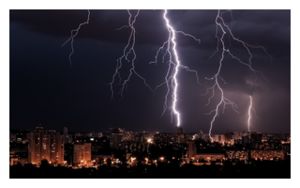Sun's shifting magnetic field may predict lightning strikes
The sun may be partly responsible for lightning strikes on Earth, and scientists think fluctuations in the sun's magnetic field could be used to predict lightning storms weeks in advance.
The sun's magnetic field can bend Earth's own magnetic field, and this twisting and turning may be allowing an influx of high-energy particles into the planet's atmosphere. These particles can cause a buildup of electric charge that can trigger lightning strikes.
From 2001 to 2006, during a period when the sun's magnetic field was severely skewing the Earth's magnetic field, the United Kingdom saw 50 percent more lightning strikes than normal, according to the new study.
This severe skewing happens regularly as the sun's magnetic field shifts. Scientists say this suggests the sun's magnetic field could be used to predict the occurrence of lightning.
"We now plan to combine regular weather forecasts, which predict when and where thunderclouds will form, with solar magnetic field predictions," Matt Owens, a professor of space environment physics at the University of Reading in the United Kingdom, said in a statement. "This means a reliable lightning forecast could now be a genuine possibility."
Earth would be a barren wasteland without a magnetic field. The magnetic field shields the planet from blasts of particles from space, such as high-energy cosmic rays and dangerous solar winds.
The sun's magnetic field acts like a bar magnet. As the sun rotates, the magnetic field is either pointing at the Earth or pointing away from it. As the sun's magnetic field shifts around, it pulls the Earth's weaker magnetic field with it.
The 50 percent increase in lightning strikes in the U.K. happened when the sun's magnetic field was pointing away from Earth. During that time, Earth's warped magnetic field made some spots in the upper atmosphere more vulnerable to cosmic rays - streams of high-energy particles that come from the shock waves of giant exploded stars.
Previous research has already shown that cosmic rays can trigger lightning. Storm clouds build up excess electric charge, but not enough for a spontaneous discharge (a bolt of lightning). Researchers think the extra charge comes from cosmic rays that make it through Earth's magnetic field.
"From our results, we propose that galactic cosmic rays are channeled to different locations around the globe, which can trigger lightning in already charged-up thunderclouds," Owens said. "The changes to [Earth's] magnetic field could also make thunderstorms more likely by acting like an extra battery in the atmospheric electric circuit, helping to further 'charge up' clouds."
Scientists have been able to predict the polarity of the sun's magnetic field for more than 40 years. However, this is the first study that suggests the polarity of the sun's magnetic field could have a direct influence on weather on Earth. To adapt the research into a lightning predictor, weather forecasters will need to combine normal weather predictions with predictions of how the sun's magnetic field will shift, the researchers said. Owen and his colleagues now plan to test if combining the data can accurately predict lightning.
The new study was published Wednesday (Nov. 19) in the journal



0 reacties:
Post a Comment